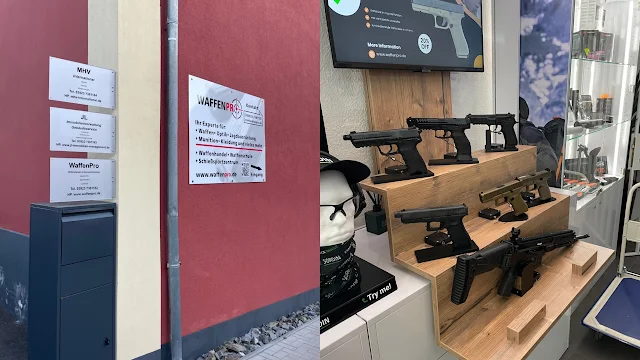Modern airsoft guns closely resemble real firearms in both appearance and operation, making them popular among enthusiasts. Due to their affordability and the ability to practice at home, some people use airsoft guns as training tools for live-fire shooting.
For people like me, who live in countries with strict firearm regulations or limited access to shooting ranges, airsoft guns may not be the ideal alternative, but they can still serve as an excellent training tool.
Skills I Developed with Airsoft
Reflecting on the past three months, I found airsoft guns useful for practicing key firearm handling skills, such as shooting with both eyes open, magazine changes, trigger control, and grip training. These exercises have the potential to improve real handgun shooting skills.
Initially, my handgun accuracy was terrible—I even missed a paper target. However, after two months of consistent practice with an airsoft gun, my shot grouping and accuracy improved significantly, and I gained confidence in handling a pistol. but there was something that Airsoft gun couldn't help with.
 |
The Results of My First Live-Fire Shooting After Two Months of Training with an Airsoft Gun. You can find my previous post about my experience with the effectiveness of airsoft guns here. |
The Limitation of Airsoft: Recoil
The biggest limitation of airsoft guns is their weak recoil compared to real firearms.
If you're shooting something like a .22LR, recoil isn’t a major concern(I have shot a pistol using .22mm rounds, and it only felt slightly stronger than an airsoft gun. But never underestimate it—.22mm is still dangerous enough to kill). However, most handgun users shoot 9mm rounds, and the recoil from these is on a completely different level from airsoft guns.
Since I had trained extensively with airsoft on sight alignment and pistol handling, I felt confident going into live-fire shooting. However, controlling recoil turned out to be much more difficult than I expected.
 |
| Here's a shot of me doing live ammo shooting during my Prague trip. You can definitely see I had quite a bit of muzzle flip |
Trial and Error in Recoil Control
I had studied pistol grip techniques from various YouTube tutorials and practiced them with my airsoft gun. I assumed that because I understood the technique, I would have no problem managing recoil in live-fire shooting. Additionally, I regularly do weight training, so I believed I had enough strength to handle the recoil.
But guess what happened?
I was wrong.
When I finally got to shoot live rounds, my grip wasn’t strong enough, and I flinched more than I expected. Trying to forcefully suppress my flinch led to unnatural anticipation, which significantly reduced my accuracy.
Afterward, I recorded my shooting stance and posted it on Reddit for feedback. That’s when I discovered the following issues:
My grip wasn’t strong enough.
I didn’t lock out my elbows.
I wasn’t leaning forward slightly.
I had focused so much on trigger control and aiming that my body was too relaxed while shooting. As a result, the recoil pushed me backward more than it should have, and because my elbows weren’t locked, the recoil transferred directly to my forearms, causing excessive muzzle flip.
Training for Better Recoil Control
For my next shooting session, I wanted to improve my recoil control, so I made an effort to remember as much as I could about the recoil of a 9mm round from my live-fire experience. I also focused on improving my stance and grip.
Athletic Stance
The stance itself wasn’t that difficult to improve. Simply adopting what we call the "athletic stance" and shifting more of my weight onto the front foot was enough. Whenever I trained with my airsoft gun at home, I always made sure to pay attention to maintaining the athletic stance, and even though the recoil of the airsoft gun is much weaker compared to a real firearm, I tried to keep my body stable as if preparing for the real recoil.
 |
| If you look at the stances of boxers, you'll get a good understanding of what an athletic stance is. |
Grip Strength and Wrist Lock Check
Using a technique I learned from YouTube, I pressed my gun firmly against a wall or a solid surface to check if my wrist remained locked. I also placed my gun on a table and pressed down hard to test if it would rotate, ensuring that my wrist maintained stability.
 |
I recommend placing a small cloth or towel to prevent damage to the gun. And don't worry, in Germany, it's not mandatory to attach color parts to airsoft guns. |
Elbow Lockout Practice
This was inspired by the recoil control tips video from shooting legend Jerry Miculek. Following his suggestion, I used an airsoft gun to practice the exercise where you grip a stick and press it down strongly. I held the pistol firmly, just like I would when shooting, and placed the front of the gun on a desk or bookshelf. From there, I lowered the gun slightly while maintaining it flat.
Through this exercise, I was able to experience how it feels when my elbows are naturally locked out, and I also got a sense of how stabilizing the arms with large muscles like the lats feels.
Grip Strength Training
Since a stronger grip can lead to more stable shooting, I added grip-strengthening exercises like Farmer’s Walk, kettlebell grip squeezes, and dead hangs to my workout routine.
Real Test: The Results?
Last evening, I took a 40-minute train ride to a shooting range and rented a Glock 17, the same model as my airsoft gun, to test my improvements.
 |
A shooting range located in Zerbst, Germany. Sexy guns were elegantly displayed. I wonder if one day I’ll have the chance to own real firearms in my own home. |
 |
| Here’s a shot of me loading live ammo. I was having some small talk with the instructor. |
Before shooting, I repeatedly reminded myself:
Strong grip, maintain tension in my body, lean forward slightly, and lock out my elbows!
The result? It was really interesting!
 |
| Shooting results from 15 meters. I think I’ve improved a lot compared to before! |
Of course, my recoil control wasn’t as smooth as that of professional shooters on YouTube, but I could definitely notice some improvement in managing it.
Previously, my sights would jump completely out of view after every shot. This time, the recoil was much more manageable, allowing me to realign my sights faster. Additionally, the initial accuracy issues caused by the trigger weight difference improved as my grip became stronger.
Unfortunately, I didn’t realize that my phone camera was recording from a completely wrong angle, so I couldn’t get a good comparison video. However, I could still feel the difference—the recoil was noticeably less disruptive, making my shooting more stable.
Conclusion
While airsoft guns are not a perfect substitute for live-fire training, they are incredibly useful for preparing for real shooting sessions. However, it’s important to remember that training only with airsoft may lead to weaknesses in recoil control.
That’s why, if you live in a country where real firearm shooting is possible, I highly recommend doing live-fire training at least once a month. This will help you experience the true recoil and power of a real gun, allowing you to apply that understanding to your airsoft training.
I plan to continue practicing and refining my shooting technique. Hopefully, in my next live-fire session, I’ll see even greater improvement in my recoil management!





Comments
Post a Comment